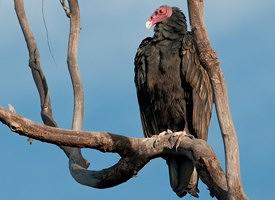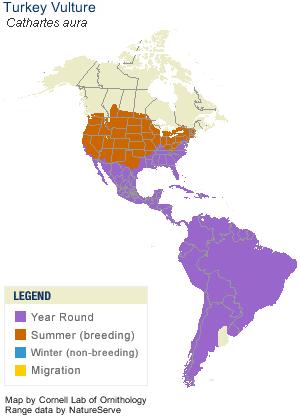 |
Canku Ota
|
 |
|
(Many Paths)
|
||
|
An Online Newsletter
Celebrating Native America
|
||
|
June 2016 - Volume 14
Number 6
|
||
|
|
||
|
Turkey Vulture
(Cathartes aura) |
||
|
by Cornell Lab of Ornithology
|
||
|
At a Glance
Cool Facts
Turkey Vultures eat carrion, which they find largely by their
excellent sense of smell. Mostly they eat mammals but are not above
snacking on reptiles, other birds, amphibians, fish, and even invertebrates.
They prefer freshly dead animals, but often have to wait for their
meal to soften in order to pierce the skin. They are deft foragers,
targeting the softest bits first and are even known to leave aside
the scent glands of dead skunks. Thankfully for them, vultures appear
to have excellent immune systems, happily feasting on carcasses
without contracting botulism, anthrax, cholera, or salmonella. Unlike
their Black Vulture relatives, Turkey Vultures almost never attack
living prey.
Nest Description Turkey Vultures don’t build full nests. They may scrape out a spot in the soil or leaf litter, pull aside obstacles, or arrange scraps of vegetation or rotting wood. Once found, many of these nest sites may be used repeatedly for a decade or more.
Turkey Vultures nest in rock crevices, caves, ledges, thickets,
mammal burrows and hollow logs, fallen trees, abandoned hawk or
heron nests, and abandoned buildings. These nest sites are typically
much cooler (by 13°F or more) than surroundings, and isolated
from human traffic or disturbance. While they often feed near humans,
Turkey Vultures prefer to nest far away from civilization.
The Turkey Vulture's distinctive slow, teetering flight style
probably helps the bird soar at low altitudes, where it is best
able to use its nose to find carrion. At other times they may soar
high on thermals and form mixed flocks or kettles. On the ground
they move with ungainly hops and are less agile than Black Vultures.
Often, especially in the morning, they can be seen standing erect,
wings spread in the sun, presumably to warm up, cool off, or dry
off. Outside of the breeding season, Turkey Vultures form roosts
of dozens to a hundred individuals. When Turkey Vultures court,
pairs perform a "follow flight" display where one bird
leads the other through twisting, turning, and flapping flights
for a minute or so, repeated over periods as long as 3 hours. Migrating
flocks can number in the thousands. At carcasses, several Turkey
Vultures may gather but typically only one feeds at a time, chasing
the others off and making them wait their turn. Despite their size,
Turkey Vultures are often driven off by smaller Black Vultures,
Crested Caracaras, Zone-tailed Hawks, and other species.
Turkey Vultures increased in number across North America from 1966 to 2014, according to the North American Breeding Bird Survey. Partners in Flight estimates a global breeding population of 18 million with 28% spending some part of the year in the U.S., 9% in Mexico, and 1% breeding in Canada. The species rates a 5 out of 20 on the Continental Concern Score. Turkey Vulture is not on the 2014 State of the Birds Watch List. These birds were threatened by side-effects of the pesticide DDT, but today they are among the most common large carnivorous birds in North America. However, because they live on rotting meat, like California Condors, they can fall victim to poisons or lead in dead animals. The main concern is lead shot that ends up in carcasses or gut piles left by hunters. The animals eat the shot and eventually suffer lead poisoning. Other threats include trapping and killing due to erroneous fears that they spread disease. Far from it, vultures actually reduce the spread of disease. |
||||||||||||||||||||||||||||||||
|
|
|
||
|
|
||
| Canku Ota is a free Newsletter celebrating Native America, its traditions and accomplishments . We do not provide subscriber or visitor names to anyone. Some articles presented in Canku Ota may contain copyright material. We have received appropriate permissions for republishing any articles. Material appearing here is distributed without profit or monetary gain to those who have expressed an interest. This is in accordance with Title 17 U.S.C. Section 107. | ||
|
Canku Ota is a copyright ©
2000 - 2016 of Vicki Williams Barry and Paul Barry.
|
||
 |
 |
|
|
The "Canku
Ota - A Newsletter Celebrating Native America" web site and
its design is the
|
||
|
Copyright ©
1999 - 2016 of Paul C. Barry.
|
||
|
All Rights Reserved.
|
||
 If
you’ve gone looking for raptors on a clear day, your heart
has probably leaped at the sight of a large, soaring bird in the
distance– perhaps an eagle or osprey. But if it's soaring with
its wings raised in a V and making wobbly circles, it's likely a
Turkey Vulture. These birds ride thermals in the sky and use their
keen sense of smell to find fresh carcasses. They are a consummate
scavenger, cleaning up the countryside one bite of their sharply
hooked bill at a time, and never mussing a feather on their bald
heads.
If
you’ve gone looking for raptors on a clear day, your heart
has probably leaped at the sight of a large, soaring bird in the
distance– perhaps an eagle or osprey. But if it's soaring with
its wings raised in a V and making wobbly circles, it's likely a
Turkey Vulture. These birds ride thermals in the sky and use their
keen sense of smell to find fresh carcasses. They are a consummate
scavenger, cleaning up the countryside one bite of their sharply
hooked bill at a time, and never mussing a feather on their bald
heads.




